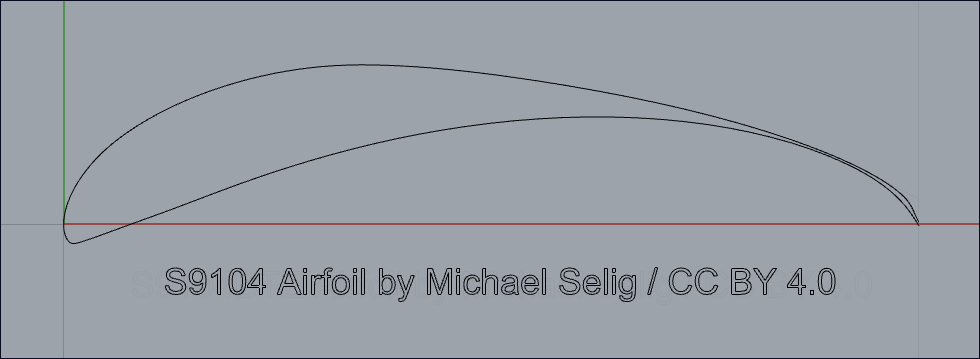 S9104
-----
The S9104 airfoil was designed using PROFOIL to have higher lift than
the S1223. The airfoil was analyzed in XFOIL. From XFOIL predictions,
the S9104 (at an angle of attack of 11 deg) reaches a maximum lift
coefficient 2.59 at a Reynolds number of 200,000 with Ncrit = 9, which
is the default Ncrit value in XFOIL. Compared with the S1223, the
S9104 shows more than a 10% improvement in maximum lift coefficient.
The S9104 airfoil and XFOIL predictions are shown below. The S1223
predictions are shown for comparison.
While the trailing edge region of the new design is very thin, it
could be fabricated from carbon fiber fabric laid in a mold, and then
inlaid or molded into the forward section of the airfoil.
For roll control on an airplane, if any type of aileron is used,
deflection should be up to dump lift. It is unlikely that down
deflection would be beneficial. Alternatively, spoilerons could be
used for roll control. In that case, the spoileron should be aft of
the 50% chord location so as to have little interaction with the
laminar separation bubble.
Fixing transition to reduce or eliminate the size of the upper surface
laminar separation bubble resulted in less max lift. In other words,
the airfoil relies on the laminar separation bubble for max lift.
Therefore, the airfoil surface should be smooth and accurate forward
of the ~40% chord location so as not to cause transition and reduce
the size of the laminar separation bubble.
For the XFOIL predictions below (XFOIL v6.96), the number of
coordinate points used in the analysis was 160. These points were
obtained in XFOIL by loading the airfoils, and then using:
"ppar | n | 160" to repanel the airfoils, each to have 160 points.
Then the analysis was done using "oper" with Re = 200,000. The higher
number of points gives greater accuracy than using the original 81
coordinates.
S9104
-----
The S9104 airfoil was designed using PROFOIL to have higher lift than
the S1223. The airfoil was analyzed in XFOIL. From XFOIL predictions,
the S9104 (at an angle of attack of 11 deg) reaches a maximum lift
coefficient 2.59 at a Reynolds number of 200,000 with Ncrit = 9, which
is the default Ncrit value in XFOIL. Compared with the S1223, the
S9104 shows more than a 10% improvement in maximum lift coefficient.
The S9104 airfoil and XFOIL predictions are shown below. The S1223
predictions are shown for comparison.
While the trailing edge region of the new design is very thin, it
could be fabricated from carbon fiber fabric laid in a mold, and then
inlaid or molded into the forward section of the airfoil.
For roll control on an airplane, if any type of aileron is used,
deflection should be up to dump lift. It is unlikely that down
deflection would be beneficial. Alternatively, spoilerons could be
used for roll control. In that case, the spoileron should be aft of
the 50% chord location so as to have little interaction with the
laminar separation bubble.
Fixing transition to reduce or eliminate the size of the upper surface
laminar separation bubble resulted in less max lift. In other words,
the airfoil relies on the laminar separation bubble for max lift.
Therefore, the airfoil surface should be smooth and accurate forward
of the ~40% chord location so as not to cause transition and reduce
the size of the laminar separation bubble.
For the XFOIL predictions below (XFOIL v6.96), the number of
coordinate points used in the analysis was 160. These points were
obtained in XFOIL by loading the airfoils, and then using:
"ppar | n | 160" to repanel the airfoils, each to have 160 points.
Then the analysis was done using "oper" with Re = 200,000. The higher
number of points gives greater accuracy than using the original 81
coordinates.
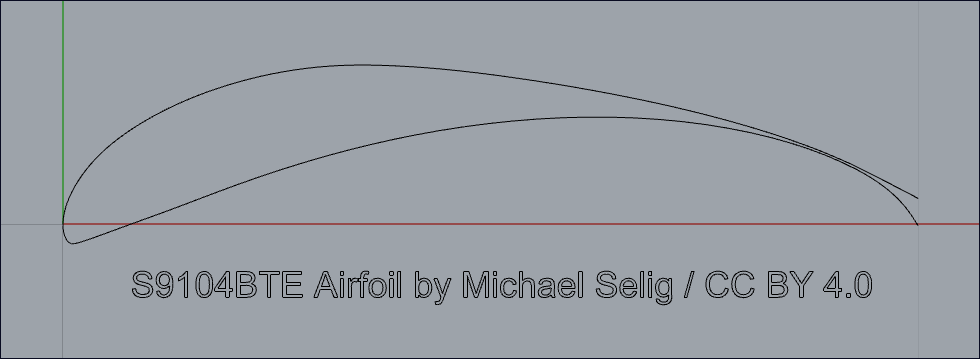 S9104BTE
--------
The S9104 was converted to having a blunt trailing edge -- "BTE". This
BTE variant is predicted to reach a Clmax of nearly 2.8 (2.7864).
Making the trailing edge blunt converts the airfoil to having an
"integral Gurney flap" in effect. There is a 14% drag penalty
(predicted) for having a blunt trailing edge to attain higher max lift.
This airfoil is predicted to have 22% more lift than the S1223 for a
Reynolds number of 200,000.
S9104BTE
--------
The S9104 was converted to having a blunt trailing edge -- "BTE". This
BTE variant is predicted to reach a Clmax of nearly 2.8 (2.7864).
Making the trailing edge blunt converts the airfoil to having an
"integral Gurney flap" in effect. There is a 14% drag penalty
(predicted) for having a blunt trailing edge to attain higher max lift.
This airfoil is predicted to have 22% more lift than the S1223 for a
Reynolds number of 200,000.
These airfoils are released under the CC BY 4.0 license.
Coordinates: s9104.dat s9104.txt [same coordindate data, different file extensions] Coordinates as a NURB curve: s9104.dxf Coordinates as a NURB curve [Rhino]: s9104.3dm Coordinates: s9104BTE.dat s9104BTE.txt [same coordindate data, different file extensions] Coordinates as a NURB curve: s9104BTE.dxf Coordinates as a NURB curve [Rhino]: s9104BTE.3dm
S9104 s9104.pdf
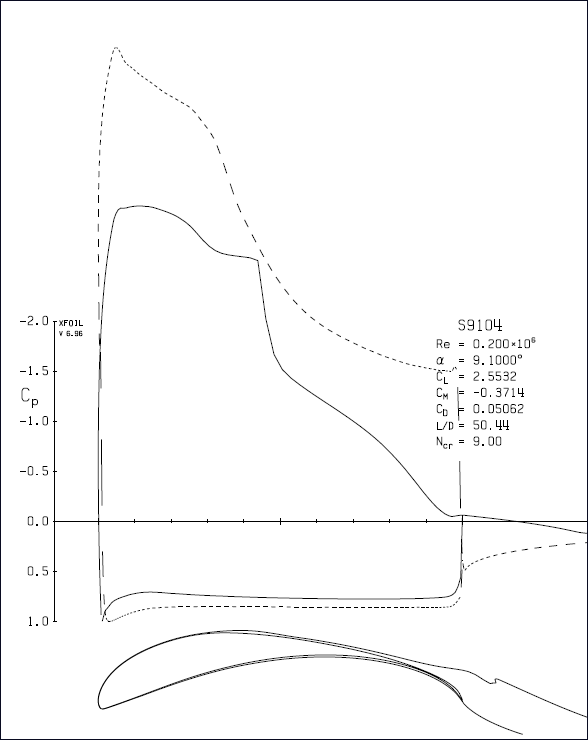
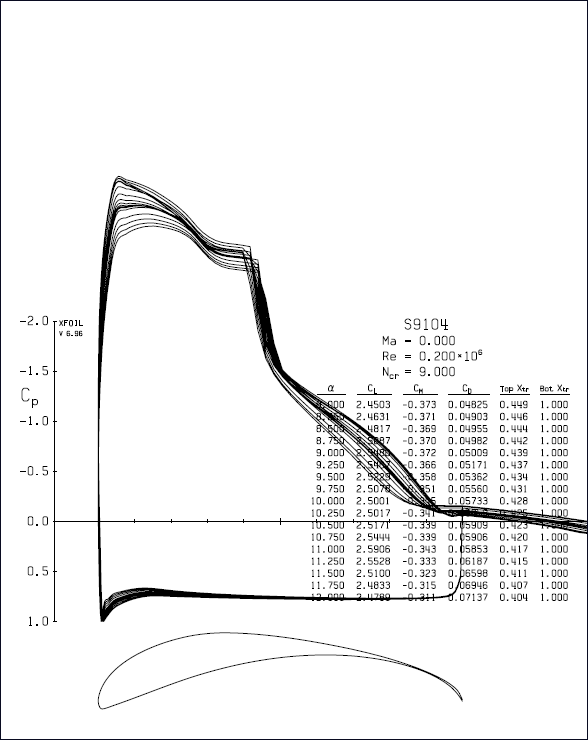
S9104BTE (blunt trailing edge) s9104BTE.pdf
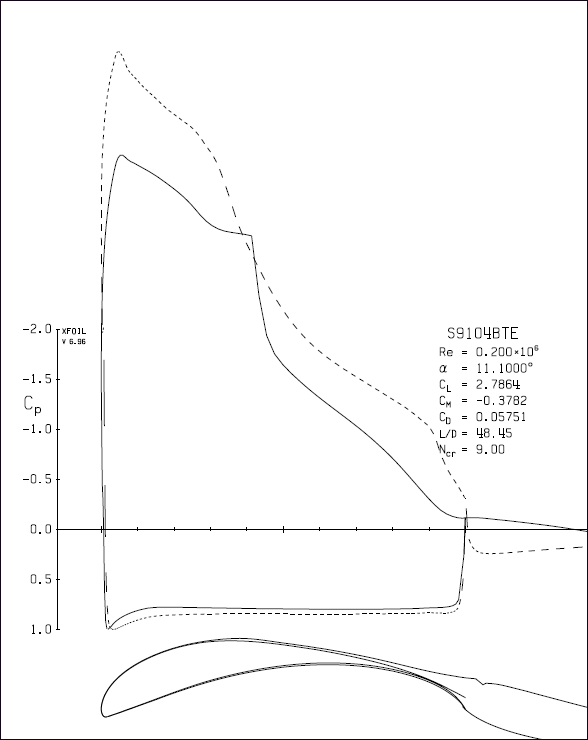
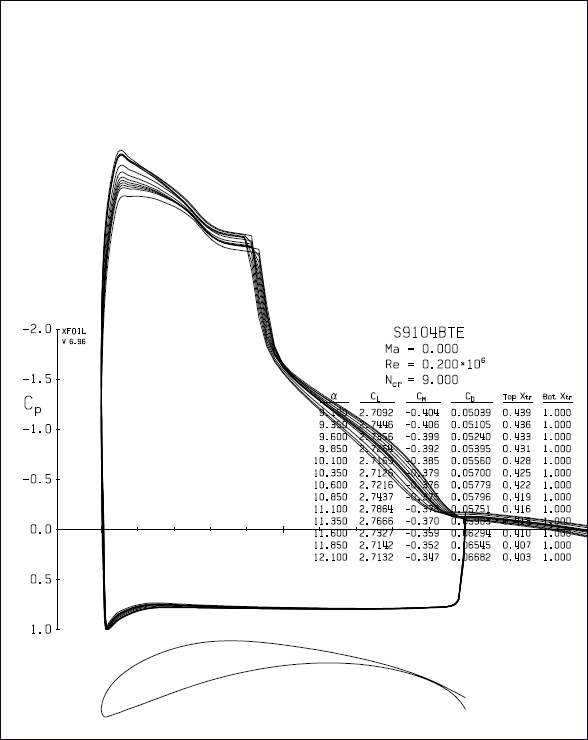
S1223 for comparision s1223-single-alpha.pdf s1223-alfa-sweep.pdf
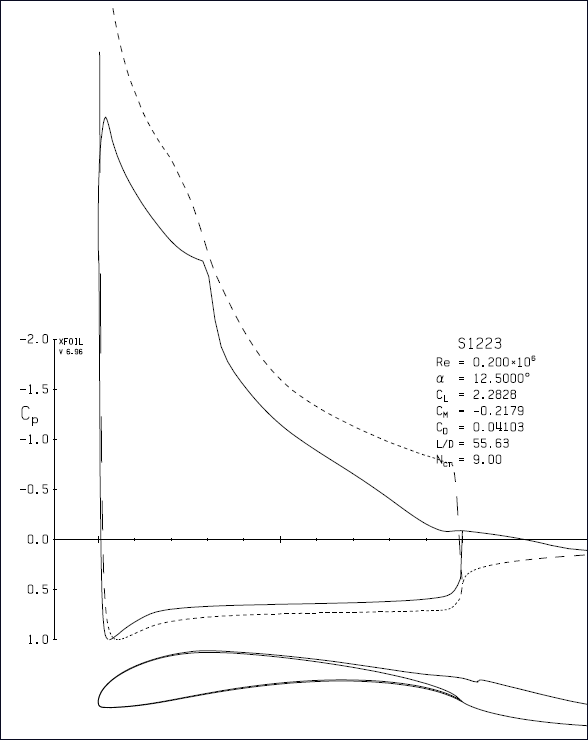
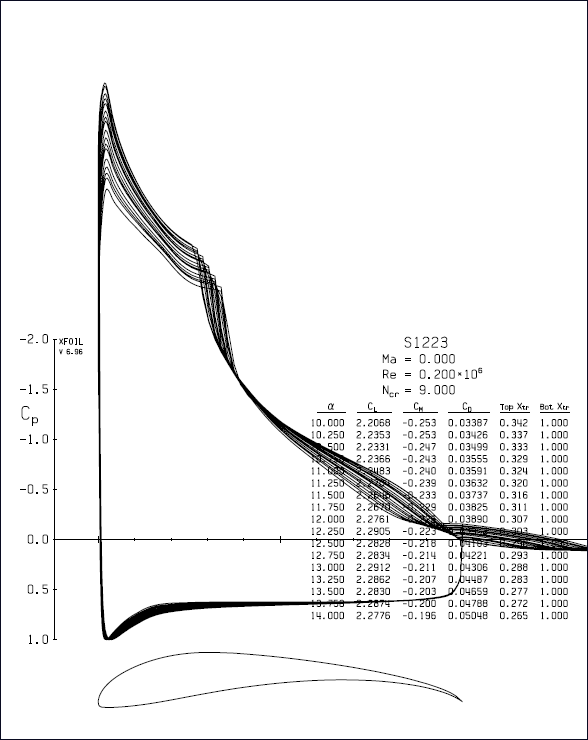
All png images above: all-png-images.psd
PROFOIL for Inverse Airfoil Design on Github https://github.com/m-selig/PROFOIL PROFOIL-UI (User Interface) on Github https://github.com/kjayawar/PROFOIL-UI
****************************************************** Michael Selig Professor Emeritus of Aerospace Engineering College of Engineering and Research Professor Dept. of Aerospace Engineering University of Illinois at Urbana-Champaign Urbana, IL 61801-2935 m-selig@illinois.edu https://m-selig.ae.illinois.edu ******************************************************